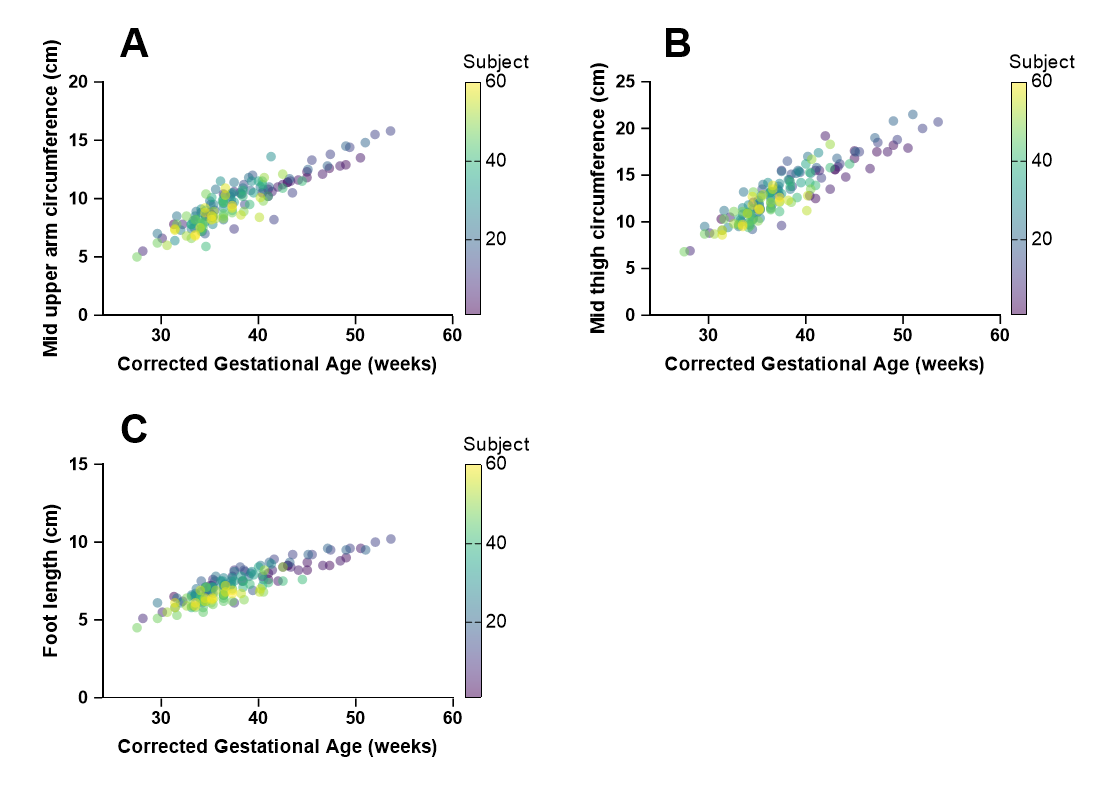Neonatal Fetal Nutrition & Metabolism 3
Session: Neonatal Fetal Nutrition & Metabolism 3
627 - Associations of Body Composition and Anthropometric Growth with Arm and Thigh Circumference and Foot Length in Neonatal Intensive Care Infants
Monday, April 28, 2025
7:00am - 9:15am HST
Publication Number: 627.3679
Stephanie Yeager, Seattle Children's/University of Washington, Seattle, WA, United States; D. Taylor Hendrixson, University of Washington School of Medicine, Seattle, WA, United States; Gregory C.. Valentine, University of Washington School of Medicine, Tacoma, WA, United States; Katie M. Strobel, University of Washington School of Medicine, Seattle, WA, United States
- SY
Stephanie Yeager, MD (she/her/hers)
Neonatal-Perinatal Fellow
Seattle Children's/University of Washington
Seattle, Washington, United States
Presenting Author(s)
Background: Mid-upper arm circumference (MUAC), mid-thigh circumference (MTC), and foot length (FL) may be cost-effective markers of nutritional status in infant populations, but there is limited research in neonatal intensive care unit (NICU) populations. Understanding the association between these measurements, body composition, and anthropometric markers such as weight z-scores can provide novel insights into neonatal growth and nutritional assessment.
Objective: To investigate the relationships between MUAC, MTC, FL, anthropometric, and body composition markers in NICU infants.
Design/Methods: We performed a prospective cohort study. Subjects admitted at two Level IV NICUs, with a gestational age of 24-46 weeks and an anticipated length of stay of at least four weeks were eligible for enrollment. MUAC, MTC, and FL were measured every two weeks during subjects NICU admission. Biceps and rectus femoris muscle cross-sectional area (CSA) were also measured utilizing ultrasound and offline image processing software. Weekly anthropometric z-scores were collected using the Fenton Preterm Growth Chart. Linear mixed models adjusting for sex and gestational age were calculated to assess the relationships between MUAC, MTC, FL, body composition, and anthropometric markers.
Results: A cohort of 60 neonates was recruited. Cohort characteristics are described in Table 1. Corrected gestational age was significantly associated with MUAC, MTC, and FL (p < 0.001 for all, Figure 1). Weight-for-age z-score was positively associated with MUAC, MTC, and FL (Table 2, p< 0.001 for each). Mid-upper arm circumference was positively associated with biceps muscle CSA, and mid-thigh circumference was positively associated with rectus femoris muscle CSA (Table 2, p< 0.0001 for each).
Conclusion(s): The study demonstrates that MUAC, MTC and FL are significantly associated with corrected gestational age and weight z-scores in NICU infants. MUAC is associated with biceps CSA, and MTC is associated with rectus femoris CSA, suggesting potential role as a non-invasive, cost-effective measure of body composition that could be used in resource limited settings. Further research with larger sample sizes and diverse populations is needed to validate these findings and determine clinical applicability.
Table 1.
.png) Demographic information of study participants. Continuous variables are presented as median (IQR).
Demographic information of study participants. Continuous variables are presented as median (IQR). Figure 1.
 Relationship of corrected gestational age with A) mid-upper arm circumference, B) mid-thigh circumference, and C) foot length. Colors represent individual subject.
Relationship of corrected gestational age with A) mid-upper arm circumference, B) mid-thigh circumference, and C) foot length. Colors represent individual subject.Table 2.
.png) Linear mixed models of mid-upper arm circumference, mid-thigh circumference, and foot length with weight z-score and body composition metrics. All models adjusted for corrected gestational age and sex.
Linear mixed models of mid-upper arm circumference, mid-thigh circumference, and foot length with weight z-score and body composition metrics. All models adjusted for corrected gestational age and sex.
